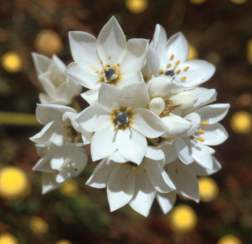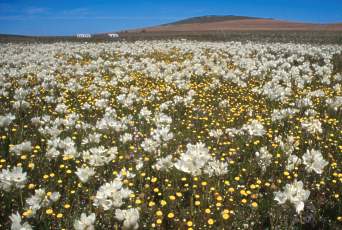Ornithogalum thyrsoides
Ornithogalum thyrsoides Jacq.
Family: Hyacinthaceae
Common names: chincherinchee, wonder-flower, star-of-Bethlehem (Eng.), tjienkerientjee, tjienk, wit-tjienk, viooltjie (Afr.)
Introduction
Showy bulbous herb of vast horticultural importance because of its long lasting flowers suitable for use as cut flowers.

Description
Description
Ornithogalum thyrsoides is a bulbous geophyte, 200 to 500 mm tall, developing large rounded bulbs that are dormant in the summer months. The plant has few (5-7) fleshy leaves that die back after flowering. Leaves range from 150 to 300 mm in length and 5 to 15 mm in width, are lance-shaped, smooth and soft-textured.
Flower stalks are leafless and produce either a tight cluster of 30-50 flowers in a raceme or a loose corymb of few (5-20) flowers with flowers reaching almost the same height. The flowers are bowl-shaped and are supported by a large green bract about the length of pedicels in open flowers. Flowers are white or creamy-white, usually with a brown or green centre that fades with age. They appear from late spring to mid summer (October to February), are long lasting and also phototropic (bending in response to light). The capsule is spindle-shaped and thin walled, splitting longitudinally to expose black, shiny, variously shaped seeds.
Conservation Status
Status
Ornithogalum thyrsoides is widespread and common in the Western Cape and not threatened. It is assessed as Least Concern (LC) by the Red List of South African Plants. Due to its wide cultivation in South Africa and abroad, there is no pressure on plants in the wild for the cut flower trade. However, like many geophytes it faces threats from land transformation that degrades the land, and lack of restoration.
It has become naturalized in Western Australia where it grows in disturbed sites.
Distribution and habitat
Distribution description
Ornithogalum thyrsoides occurs in the Northern and Western Cape Provinces of South Africa . Its distribution extends from Namaqualand to the Cape Penisula to Caledon and the Agulhas Plain. The species is found in vleis, sandy flats, lower mountain slopes and in disturbed ground. Although it is a Cape winter rainfall species, it grows well in gardens in the summer rainfall region.

Derivation of name and historical aspects
History
Ornithogalum belongs to the Hyacinthaceae that ranks among the 20 largest families in the Cape Flora. The genus in the traditional sense contains about 120 species with a distribution in Africa, Europe and Western Asia. About 114 of the species occur in southern Africa and 38 of these in the Northern and Western Cape Provinces .
Ornithogalum thyrsoides was described and illustrated in 1776 by the Dutch born botanist Jacquin, who settled in Vienna and became known as the Austrian Linnaeus. The painting appears in Hortus botanicus vindobonensis 3:17-18, Tab.28 (1776) which can be seen on Missouri Botanical Garden's rare books site.www.illustratedgarden.org/mobot/rarebooks/page.asp?relation=QK98J3151770V3&identifier=0110.
Ornithogalum means 'bird's milk' and is derived from the Greek words ornis meaning 'bird' and gala meaning 'milk', in reference to the white flowers. 'Bird's Milk' was frequently used by the Romans to indicate something wonderful (Smith, 1966).
The specific epithet thyrsoides is derived from the term thryse presumably in reference to the compact flower heads. The term is actually a misnomer as the flower heads in the species are not branched as in a thyrse, but are arranged close together in a raceme or loosely in a corymb.
The Afrikaans vernacular name tjienkerientjee is the simulation of the chink sound made when fresh stalks are rubbed against one another and is based on the name given by Thunberg in 1772 as tinkerintees. Chincherinchee is the English translation of the Afrikaans name. Both names were in use in the eighteenth century. The species was introduced to gardens in Holland before 1700 and is known to cultivation in Europe from about 1750.
The common name star-of-Bethlehem was used for the European species Ornithogalum umbellatum in reference to the spreading tepals, and was adopted for O. thyrsoides (Smith, 1966).
Ecology
Ecology
Plants of Ornithogalum thyrsoides survive the hot dry summers through dormancy. Flowering in the genus appears to be stimulated by fires. Several forms of O. thyrsoides were recognized by Leighton (1944) based on variation in floral parts but, Obermeyer (1978) indicates that the variation is in response to habitat conditions. The species prefers moist and fertile soil.
Uses
Use
Ornithogalum thyrsoides and O. conicum both with a similar distribution in the Cape, are poisonous to horses and cattle if ingested. They are also the two species used in the production of cut flowers for the long lasting vase life.
O. thyrsoides is a showy garden or container plant. It is also extensively cultivated for the floriculture trade. It is ideal for export as the flowers keep well and have an extended vase life. It is known to have been cultivated by market gardeners around Durban in KwaZulu-Natal from about 1948 to 1968 for sale as cut flowers in the city market. At present, Durban relies on cut flowers of the species from Western Cape.
Flower stalks are placed in food dyes and the flowers take on the colour of the dye. The colourful flower heads are sold together with the authentic white flowers.
The species is known to be poisonous to horses and cattle if ingested by accidental grazing or from eating forage containing plant parts. It is referred to as 'Chincherinchee poisoning' and causes intestinal inflammation in cattle. The above ground parts of O. thyrsoides cause skin irritation (Watt & Breyer-Brandwijk, 1962). These authors also record that an infusion of the leaves was used as a remedy for diabetes mellitus by the Europeans.
Growing Ornithogalum thyrsoides
Grow
Ornithogalum thyrsoides is recommended as a winter-growing species for gardens and containers ( Duncan, 2000). Chincherinchees are propagated mainly by separation of bulbils from bulbs and to a lesser extent by seed germination. Good soil, water and temperature conditions support large sized flowers. Plants growing in soil lacking water and nutrients produce smaller flowers. The species would do well in a sunny aspect with free air circulation, well-drained soil and slightly sloping ground in gardens.
Another attractive species for gardens in summer rainfall areas is Ornithogalum saundersiae
References
- Goldblatt, P. & Manning, J. 2002. Cape plants: a conspectus of the Cape Flora of South Africa . Strelitzia 9. National Botanical Institute, Pretoria and MBG Press, Missouri Botanical Garden, St Louis .
- Duncan, G.D. 2000. Grow bulbs: a guide to species, cultivation and propagation of South African bulbs. National Botanical Institute, Kirstenbosch.
- Hutchings, A. 1996. Zulu Medicinal Plants: an inventory. University of Natal Press, Pietermaritzburg.
- Leighton, F.M. 1944. A revision of the South African species of Ornithogalum L. Journal of South African Botany 10: 83-110 (pt. 1).
- Leistner, O.A. (ed.). 2000. Seeds plants of southern Africa : families and genera. Strelitzia 10. National Botanical Institute, Pretoria.
- Obermeyer, A.A. 1978. Ornithogalum : a revision of the southern African species. Bothalia 12: 323-376.
- Smith , C.A. 1966. Common names of South African plants. Memoirs of the Botanical Survey of South Africa No. 35. The Government Printer, Pretoria.
- Watt, J.M. & Breyer-Brandwijk, M.D. 1962. The medicinal and poisonous plants of southern and eastern Africa . E & S Livingstone Ltd., Edinburgh and London.
Credits
Yashica Singh
KwaZulu-Natal Herbarium
December 2005
Plant Attributes:
Plant Type: Bulb
SA Distribution: Northern Cape, Western Cape
Soil type: Sandy
Flowering season: Early Summer
PH: Acid
Flower colour: White
Aspect: Full Sun
Gardening skill: Average
Special Features:
Horticultural zones










Rate this article
Article well written and informative
Rate this plant
Is this an interesting plant?
User Comments
Ellen Wright, South Africa
May 29, 2017 at 5:53 PMWhere can I buy these bulbs? A flower arrangement, received at a family wedding, had 2 stalks of chincherinchees amongs white roses, etc. and are still beautiful after 23 days!!
Yashica Singh, South Africa
March 30, 2018 at 7:01 PMDear Ellen. Not sure if you got any success with locating suppliers of chincherinchees. Try HADECO, a branch in your province.
Login to add your Comment
Back to topNot registered yet? Click here to register.